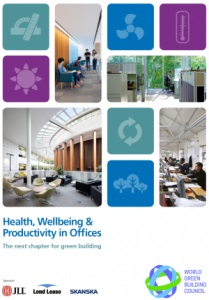
by Brianna Crandall — October 22, 2014—A new report from the World Green Building Council (WorldGBC) finds “overwhelming evidence” that office design significantly impacts the health, well-being and productivity of staff. The report found that a range of factors — from air quality and lighting, to views of nature and interior layout — can affect the health, satisfaction and job performance of office workers.
Sponsored by JLL, Lend Lease and Skanska, the report also presents a simple toolkit that businesses can use to measure the health, well-being and productivity of their buildings and to inform financial decision-making. Understanding the link between workers and their workplace helps to drive the business case for higher quality, healthy and greener buildings, valued by investors, developers and tenants alike, points out WorldGBC.
With salaries and benefits typically responsible for 90 percent of an organization’s expenditure, any higher construction or occupation costs are far outweighed by even small improvements in staff performance, opines the organization.
“The evidence linking good office design and improved health, well-being and productivity of staff is now overwhelming. There is unquestionably a clear business case for investing in, developing and occupying healthier, greener buildings,” says Jane Henley, CEO of the World Green Building Council. “Most businesses are already sitting on a treasure trove of information that can have an immediate impact on their two biggest expenses — people and buildings. Understanding the relationship between the two can help businesses achieve significant competitive advantage.”
Summary of evidence
- Indoor air quality (IAQ): A comprehensive body of research suggests that better IAQ (low concentrations of CO2 and pollutants and high ventilation rates) can lead to productivity improvements of 8%-11%.
- Thermal comfort: Research demonstrates that thermal comfort has a significant impact on workplace satisfaction, and modest degrees of personal control over thermal comfort can return single-digit improvements in productivity.
- Lighting and views of nature: Several studies have estimated productivity gains as a result of proximity to windows, with experts now thinking that views from windows are probably the more significant factor, particularly where the view offers a connection to nature.
- Noise and acoustics: Research suggests that being productive in the modern knowledge-based office is practically impossible when noise provides an unwanted distraction. This can be a major cause of dissatisfaction amongst occupants.
- Interior layout: The way the interior of an office is configured (including workstation density and configuration of work space, breakout space and social space) has been found to have an impact on concentration, collaboration, confidentiality and creativity.
- Active design and exercise: Health can be improved through exercise, and so active design within a building, and access to services and amenities such as gyms, bicycle storage and green space can help to encourage healthier lifestyles of building occupants.
Toolkit to measure health, well-being and productivity
- Financial metrics: Absenteeism, staff turnover, revenue breakdown (by department or per building), medical costs and complaints, and physical complaints.
- Perceptual metrics: Studies that test a range of self-reported attitudes into health, well-being and productivity in the workplace can contain a wealth of information for improving office performance.
- Physical metrics: Direct measures of the physical office environment, such as temperature, are key to measuring the effect on the health, well-being and productivity of workers. Exciting developments in this area such as portable and wearable technology are likely to substantially expand our understanding.
Downloadable from the WorldGBC Web site, Health, Wellbeing and Productivity in Offices: The Next Chapter for Green Building, builds upon the 2013 WorldGBC report The Business Case for Green Building, which featured a chapter on the health and productivity benefits of green buildings.
The new report was launched in London, England, as part of World Green Building Week. Global launch events hosted by Green Building Councils are being held in the coming months in countries around the world.





